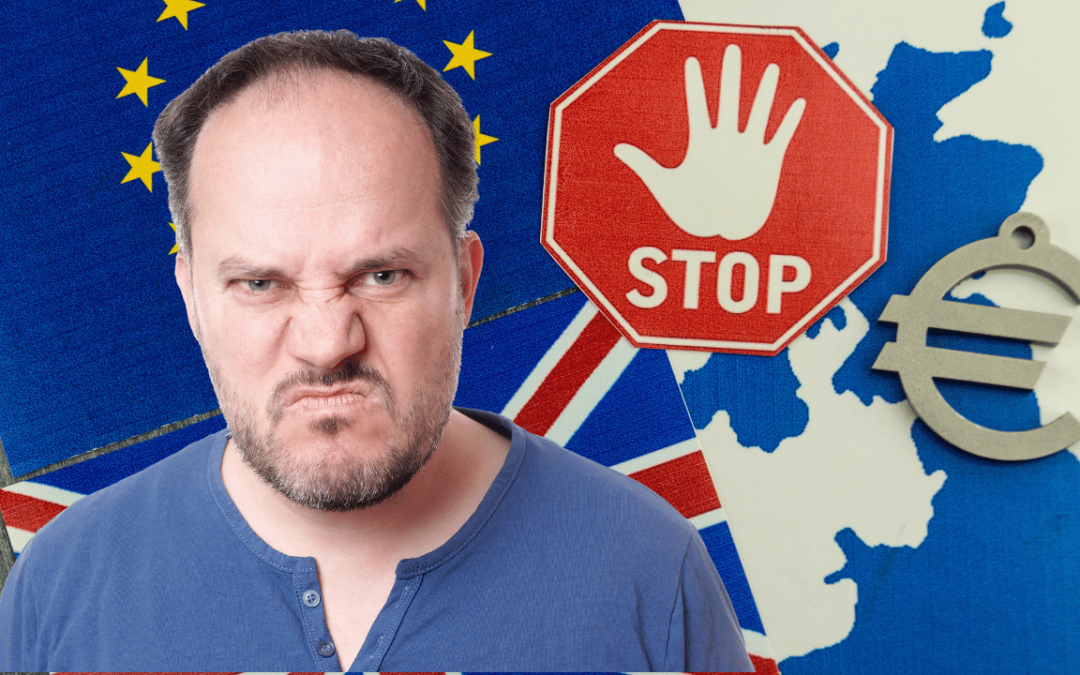I explain in straightforward terms how much money you need, the difference between savings and passive income, and whether you have to have double the amount for your residency renewal in years 2&3 and 4&5.
Prefer to watch the video? Click the picture below.
How do you work out how much money you need for the renewal of your Non Lucrative Visa for Spain? What’s the difference between savings and passive income? Do you need double the amount for years 2&3 and 4&5?
Stick around, and I’ll clear the fog of confusion for you, and give you some examples of how to work out whether you meet the financial requirement for your visa and the renewal of your residency.
So you are a non-EU citizen who’s either thinking of applying for the Non Lucrative Visa, or you’re already a resident in your first year in Spain. Either way, you’re welcome.
Let’s get straight into the questions.
What is the Non Lucrative Visa?
The Non Lucrative Visa is the official permission you need if you’re not a citizen of an EU country and you want to move to Spain. It allows you to travel here and finish off the process by registering first of all as what’s called a ‘temporary resident’ for one year.
Can I work in Spain on the NLV?
No! There are other visas for working, but the NLV doesn’t allow any gainful employment during the 5 year period of temporary residency. So it’s generally a visa for retired people or for those who have enough savings to take time off from work.
How much money do I need for the first year?
To get the visa, you need to prove you have sufficient finances to cover your stay. There’s a figure published each year to help you work out the minimum amount you need. It’s called IPREM.
How much is IPREM?
It can change each year, but now in 2023, IPREM is €600 per month.
I’m using the monthly amount because that’s what the officials use, and I believe it’s easier to understand the rest of what I’m going to tell you if you focus on the monthly amount rather than the annual amount. Trust me for now, I’ll explain in a minute.
Can I work it out in my own currency?
Exchange rates change every few seconds, and Spain uses Euros to work out what you need, so if you’ve got money in pounds or dollars for example, today it might be worth less or more than yesterday, so it’s always best to work it out in Euros. A good broker like our preferred partner Smart Currency Exchange will be able to get you a fixed rate so you know exactly how many Euros you have in advance.
How do I use IPREM to work out what I need?
For the NLV, the applicant needs 4 times IPREM, which is (600 x4) that’s €2400 per month.
If there are family members applying together, you need an extra 1 times IPREM per person. For example, a couple would need 4 x IPREM for the main applicant and 1 x IPREM for the partner, which is 5 x IPREM altogether (600 x 5). That’s €3000 per month.
If there are 2 children, that’s an extra 2 x IPREM (600 x7) a total of €4200 per month.
I know Spanish people can survive on less than that so why do I need so much more?
The reason the figures are higher for non-EU citizens is because EU citizens have more rights, they’re part of a privileged club whose members can access all that the EU has to offer. The higher amount that non-EU citizens need is all about controlling immigration from outside of the EU, and that now includes the UK as well. It is what it is.
If I can’t earn any money, what is acceptable for the financial requirement?
You can have either accessible savings or passive income.
What are accessible savings?
Accessible savings are the kind that are easily available, rather than funds that are locked up in some kind of account or investment that requires notice to draw down the money.
What is passive income?
Passive income is money you have coming in that isn’t from any kind of employment. The most common kinds are pensions, investments and rental income from property.
Do I need to have savings and passive income?
You can have one or both of these. The difference is in how you convert them into monthly amounts. For example, a pension paid monthly is already an amount per month, but if you’re getting passive income every 4 weeks for example, you need to multiple it by 13 to get 52 weeks for the annual amount, then divide by 12 months to get the monthly amount. Savings on the other hand is a single amount to last the whole year so you would divide that amount by 12 months to find out how much you have per month.
When do I renew my visa?
Let’s clear up the terminology here. The visa is basically the permission stamp to get you into Spain and apply for your residency. So it’s not your visa but your residency that you need to renew at the end of year one.
How much money do you need when you renew your residency?
The most common simplification of this is that you need twice as much money, because the residency renewal covers two years instead of just the one. But as always…

…on whether you’re talking about savings, passive income, or both. This is where it becomes vital to focus on the monthly amount rather than the annual amount.
Let’s look at some examples.
Example number 1
Here’s someone who has only passive income and no savings. To get their initial first year of residency, they would have had to prove they have at least 4xIPREM = €2400 per month coming in. Let’s say they’ve got €2500 per month. That covers the monthly amount they need even if IPREM goes up a little over the next few years. So, they don’t need twice the annual amount to cover two years, because they’re already getting enough per month (€2400 x 24 months) which is €57,600.
Example number 2
Here’s someone who has only savings in the bank. In year one, they would have needed at least (€2400 x 12 months) which is €28,800. To renew their residency for two years, they would need twice that amount (€2400 x 24 months) which is €57,600.
Example number 3
This is where it get’s slightly more complicated and we need to look at monthly and annual amounts together.
So here’s someone who has savings and passive income. Their passive income only amounts to €1600 per month, but as we know they need at least €2400, so there’s a shortfall of €800 per month, which over the first year is (800 x 12 months) that’s €9600 they’d need in savings.
Now, when it comes to renewing their residency for two years, we don’t need to double the passive income, as I said in example number 1, that’s coming in every month for 24 months so it’s already effectively double the amount over two years, all they have to double is the amount in savings, in this case it’s (9600 x 2) which is €19,200.
So if I have savings only, I can just hold two years worth of money in the bank and I’ll be covered?
Well, you have to bear in mind you’re going to need money to live on, and the officials will look at your bank statements to see how you’re doing that when it comes to renewal, so if there’s a block amount in the bank and nothing is being spent, they might be thinking you have some kind of income coming in elsewhere.
What happens if I have exactly the right amount to cover the financial requirement?
Again, look at it from the official behind the desk’s point of view. If you’re only just covering the IPREM this year and IPREM goes up in a year or two, you’re not going to have enough to cover it and they might consider that risky. They’re more likely to grant your application if you have more than enough to cover that eventuality and possibly emergencies too, because they’d consider you more financially responsible.
Can I see another example?
Example number 4
Let’s look at a couple with one child who have a mixture of savings and passive income. For their initial application, they need 4 x IPREM for the main applicant, plus 1 x IPREM for the spouse and 1 x IPREM for the child, which is 6 x IPREM (600 x6) that’s €3600 per month.
Multiply that by 12 so we have an annual amount for the calculation and you get €43,200.
Let’s say they have passive income of only €2000 per month, multiply that by 12 months and you get €24,000, so there’s a shortfall of (43,200 – 24,000) that’s €19,200. So that’s how much they’d need in savings for year one.
And for their renewal they’ll need twice the savings amount (19,200 x 2) which is €38,400.
A question that often gets asked is this
If they can live on their passive income for the whole of year one and not spend any of their savings, could they just hold at least €38,400 in a bank account for their 5 years of temporary residency?
And the simple answer is yes. But IPREM can go up like I said before, and they might have emergencies and unforeseen expenses, but all being well they can leave those savings where they are and it will be good proof during their renewal application that they’re thriving in Spain.
Can you use your Spanish property as part of the financial requirements at your renewal?

In some regions they take into account that you have no rent or mortgage to pay so your living expenses are lower. Unfortunately, there don’t seem to be any fixed, documented rules about how they work it out, but it can be put in a document and presented at your renewal appointment. An experienced local residency specialist or lawyer should be able to tell you what officials in their area are willing to take into account.
Is it easier for a retired person to apply and renew their residency, or a younger person?
Well, it’s easier for officials to gauge a retired person’s finances and plans than someone much younger. A retired person will have their passive income sorted out in the form of pensions, they’ll have access to the state healthcare system, and officials have plenty of experience of analysing their finances, they’re the most common group.
A much younger person or family on the other hand won’t be retired so officials will look carefully to make sure they’re not hiding some kind of extra income, or looking for a loop hole to sneak in and hide under the radar. It wouldn’t be the first time it’s happened, and they’re well aware of the tricks.
So you just need to be ready to answer questions about your future so that you’re not going to become a burden on the state, or look like a criminal.
What if I have some more questions?
There are a few other resources available to you on YouTooSpain. First of all, HERE is a link to the live Q&A I did with Chris from Upsticks which answers follow up questions and covers some…

…scenarios. If you can’t find your own situation on there, why not watch one of the shows live on Saturday mornings at 10am Spanish time and ask your question on the live chat, or if you miss the show, ask in the comments below the video.
Peace & Love. Let’s dance!
Article by Skatz













0 Comments